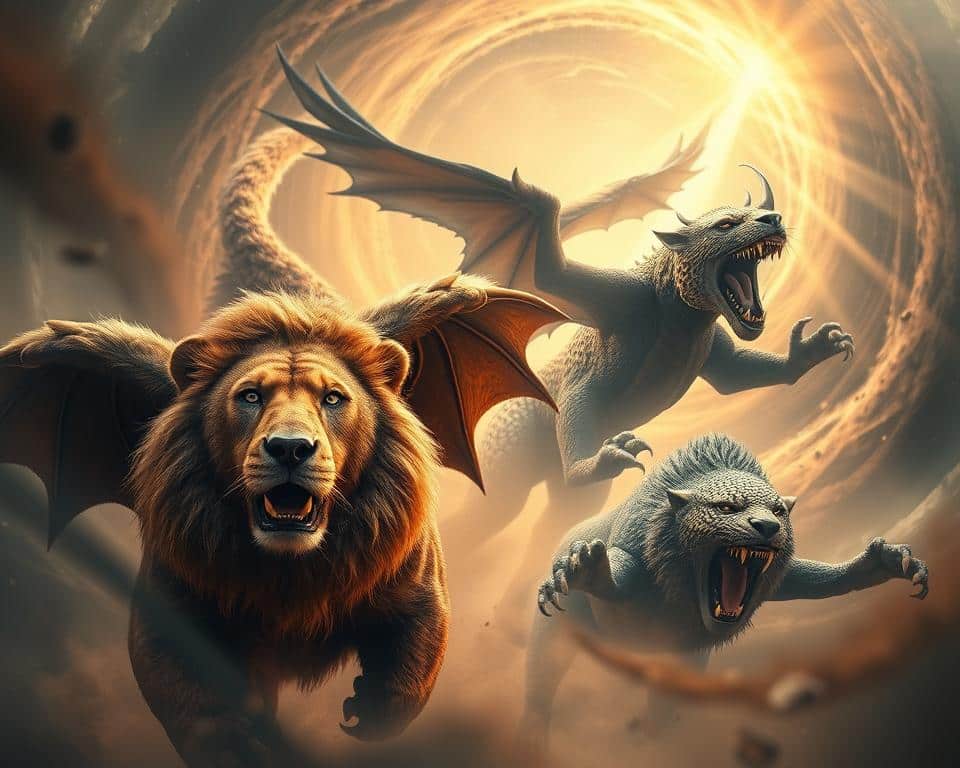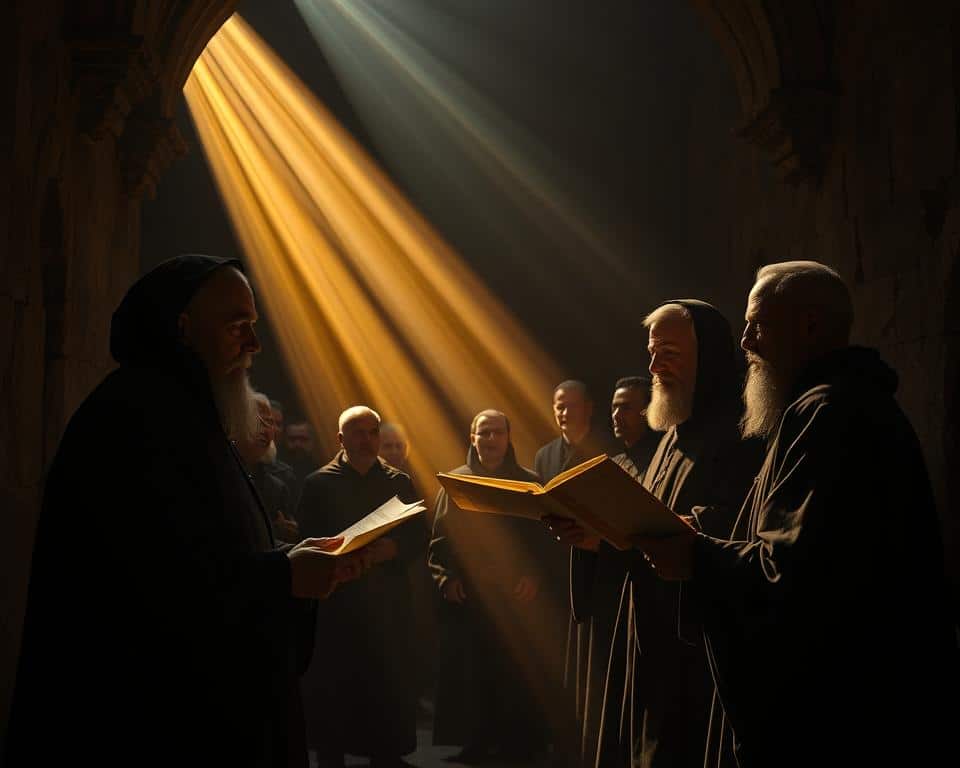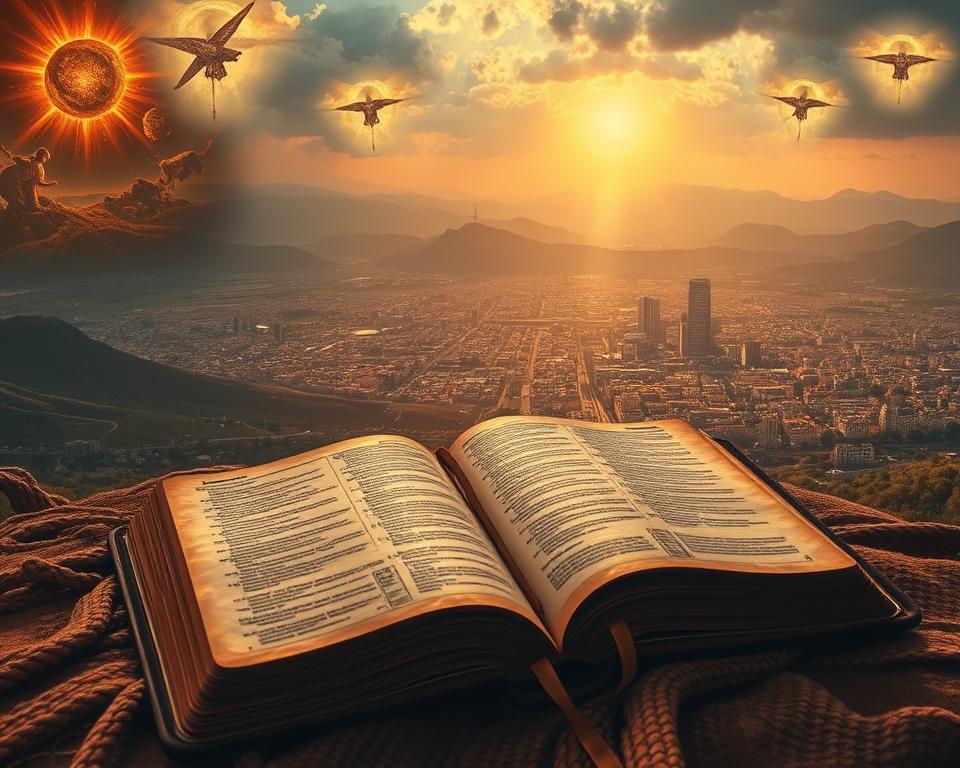Have you ever wondered about the meaning behind the strange creatures in Daniel’s vision? This powerful prophecy reveals deep truths about earthly kingdoms and God’s eternal plan. Like Nebuchadnezzar’s dream in Daniel 2, it uses vivid symbols—but with a crucial difference.
Instead of metals, the prophet sees four beasts, each representing a mighty empire. Yet, amid these earthly powers, Scripture offers hope: God’s everlasting kingdom will triumph. This vision isn’t just history—it points to the future and our ultimate victory in Christ.
Let’s uncover the meaning behind these symbols and how they connect to faith today. You’ll see why this message still matters and how it strengthens trust in God’s word.
Daniel’s Vision of Four Beasts: An Overview
Amid political upheaval, God revealed a powerful message about kingdoms. The Jewish people were exiles in Babylon when this prophecy came—Belshazzar’s first year (553 BC). A churning sea, stirred by four winds, symbolized the chaos of nations rising and falling (Daniel 7:2-3).
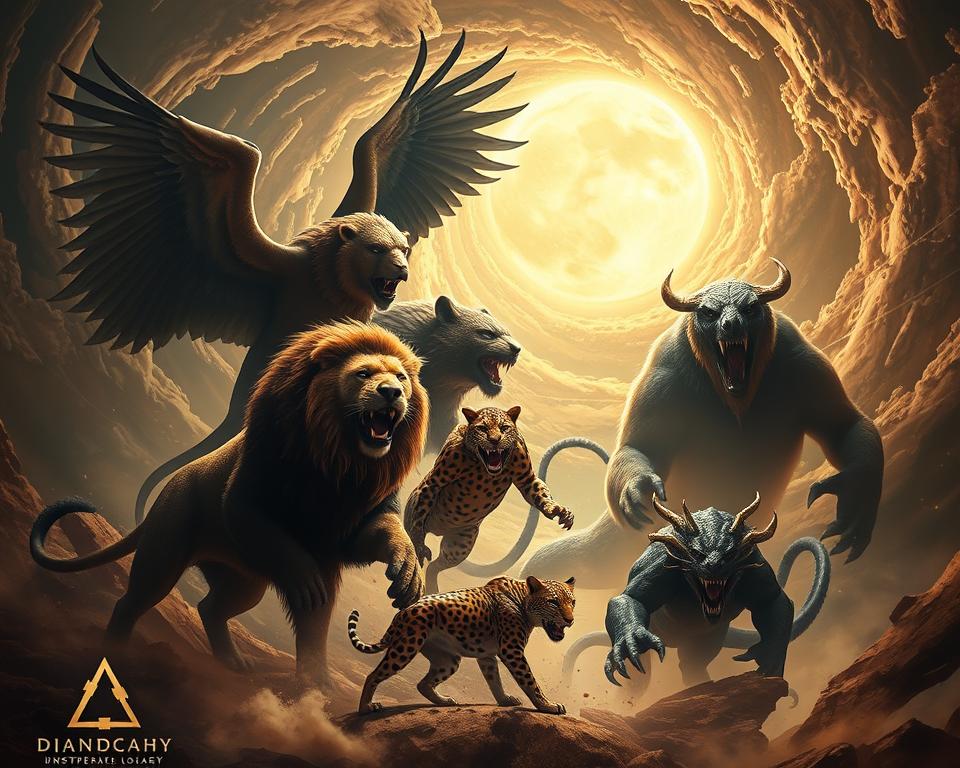
Unlike Nebuchadnezzar’s dream of a gleaming statue, this vision portrayed empires as wild beasts. The contrast is striking: human craftsmanship versus untamed ferocity. Both prophecies, however, trace the same timeline—from Babylon to Rome.
The Context of Daniel’s Prophetic Vision
Exile shaped Daniel’s perspective. Under pagan rule, God’s promises seemed distant. Yet the four beasts affirmed His control over history. The “great sea” represented earth’s rebellion, while the winds hinted at divine judgment.
Comparison to Nebuchadnezzar’s Dream
Daniel 2’s statue showcased human glory, but chapter 7 exposed its brutal nature. The metals (gold, silver, bronze, iron) aligned with the lion, bear, leopard, and iron-toothed beast. Yet Daniel 7 added critical details—like the ten horns and a boastful little horn—pointing to end-time events.
You’ll see how these symbols unfold in later sections. For now, remember: earthly powers fade, but God’s kingdom stands forever.
The First Beast: The Lion with Eagle’s Wings
A majestic lion with wings—this striking image opens the prophetic sequence. It symbolizes Babylon’s unrivaled power under Nebuchadnezzar’s reign. The lion, king of beasts, mirrored the empire’s dominance, while eagle wings depicted its rapid conquests.
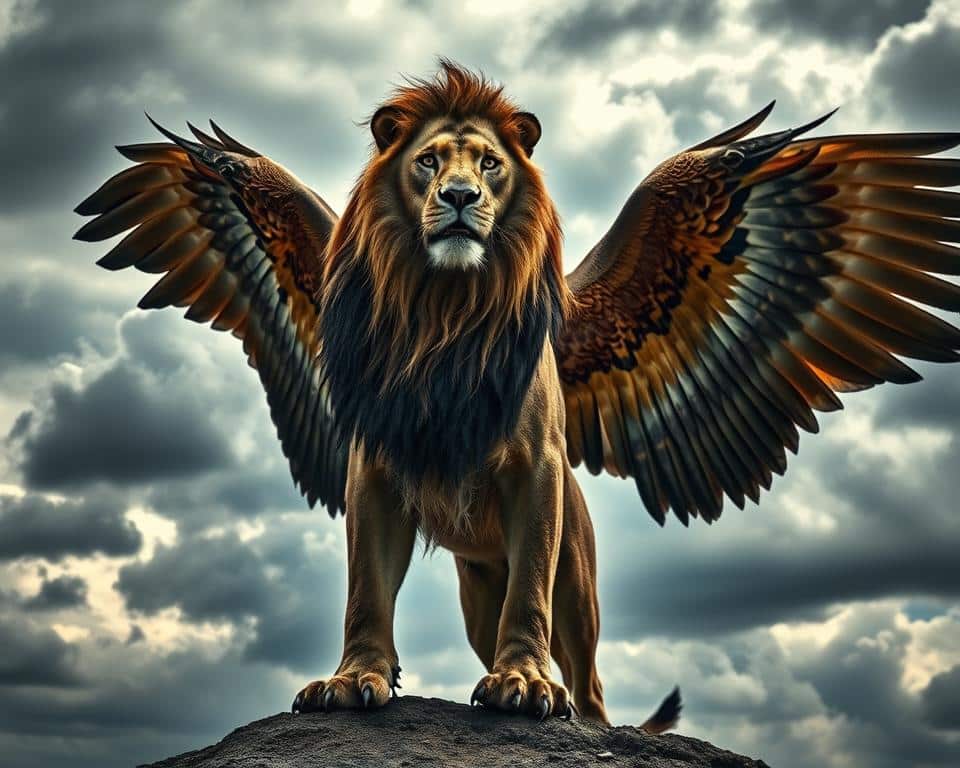
Symbolism of the Lion and Wings
The lion’s strength reflected Babylon’s military might. Eagle wings highlighted swift victories, like its takeover of Judah. Yet, the plucked wings (Daniel 7:4) signaled a divine interruption—Nebuchadnezzar’s seven-year madness (Daniel 4).
Babylon’s Empire and Nebuchadnezzar’s Humbling
Ancient Babylon celebrated lion imagery, like the Ishtar Gate. But pride preceded the king’s fall. When the beast stood upright (Daniel 7:4), it mirrored Nebuchadnezzar’s restoration after acknowledging God’s sovereignty.
This prophecy reminds us: earthly power fades, but humility aligns us with eternal truth. Even kings answer to a higher reign.
The Second Beast: The Raised Bear
Next in the sequence comes a fearsome bear, revealing God’s control over nations. Unlike the lion’s majesty, this beast’s uneven stance—raised on one side—signals a shift in power. Scripture paints a vivid picture: empires rise and fall, yet His plan remains unstoppable.
Meaning of the Raised Side
The bear’s posture highlights Persia’s dominance over Media. Though allied, Persia led the Medo-Persian Empire, just as Cyrus the Great overshadowed his Median counterparts. This duality mirrors Daniel 8:3’s ram with two horns—one longer than the other.
Conquests Symbolized by Three Ribs
The bear clutches three ribs—a metaphor for Cyrus’s victories:
- Babylon (539 BC): The empire that exiled Judah fell overnight (Daniel 5).
- Lydia (546 BC): Rich King Croesus surrendered after a 14-day siege.
- Egypt (525 BC): Persia’s expansion reached its peak under Cambyses.
“The Lord has stirred up the kings of the Medes, because His purpose is against Babylon to destroy it.”
From Gold to Ferocity
Daniel 2’s silver arms (Medo-Persia) now appear as a ravenous bear. The change reflects reality: empires grow fiercer. Yet God’s people find hope—He permits kingdoms for a time, but His truth endures.
The Third Beast: The Leopard with Four Wings and Heads
History witnessed an empire moving faster than any before—prophecy foretold it. The leopard, adorned with four wings, symbolized the Greco-Macedonian Empire’s unprecedented speed. In just 11 years, Alexander the Great conquered lands from Greece to India, fulfilling Scripture’s vivid imagery.
Swift Conquests of the Greco-Macedonian Empire
Alexander’s campaigns mirrored the leopard’s agility. His army marched 10,000 miles, toppling Persia in 334–323 BC. Like wings propelling flight, his strategies bypassed traditional warfare, securing rapid victories.
Alexander the Great and the Fourfold Division
After his untimely death at 32, the empire split into four heads—a direct fulfillment of prophecy:
- Macedonia (Cassander)
- Thrace (Lysimachus)
- Seleucid Empire (Seleucus)
- Ptolemaic Egypt (Ptolemy)
Connection to Daniel 8’s Ram and Goat
This beast aligns with Daniel 8’s goat (Greece) trampling the ram (Persia). The “broken horn” (Alexander’s death) underscores God’s control over human power. Such precision strengthens trust in Scripture’s reliability.
“The shaggy goat is the king of Greece, and the large horn between its eyes is the first king.”
You’ll see how these prophecies interlock, revealing God’s mastery over history. Earthly kingdoms rise and fall, but His word stands forever.
The Fourth Beast: Dreadful and Terrifying
Unlike the previous symbols, this final creature defies natural comparison—its brutality unmatched. Scripture depicts it with iron teeth and claws, devouring everything in its path (Daniel 7:7). No majestic lion or swift leopard, this beast embodies raw destruction.
Description of the Iron-Toothed Beast
The fourth beast crushes nations with metallic ferocity. Its feet trample remnants of earlier empires, reflecting Rome’s military dominance. Historians note Rome’s unmatched engineering—siege weapons and roads—mirroring this prophecy’s imagery.
Representation of the Roman Empire
Daniel 2’s iron legs align with this beast. The Roman Empire ruled with unprecedented control, lasting centuries. Yet its fall birthed fragmented kingdoms—the ten horns—each vying for power.
Ten Horns and Their Significance
These horns symbolize revivals, from the Holy Roman Empire to modern Europe. Revelation 13:1–2 echoes this, showing a composite beast rising from the sea. God’s plan remains clear: earthly powers fade, but His truth endures.
“The fourth beast shall be a fourth kingdom on earth, which shall be different from all other kingdoms.”
This prophecy isn’t just history—it points to Christ’s ultimate victory. As empires rise, our hope stays anchored in His eternal reign.
The Little Horn: Arrogance and Oppression
A smaller yet powerful symbol rises in the prophecy—one marked by defiance and control. Unlike the beasts before it, the little horn emerges from the fourth beast, blending religious and political authority. Its actions reveal a pattern: suppressing truth to elevate human power above God’s law.
Emergence from the Fourth Beast
This horn grows amid the ten horns of Rome’s fragments. Historically, it represents papal Rome’s rise after imperial Rome’s fall. By 538 AD, it gained supremacy, merging church and state—a direct challenge to divine authority.
Three Horns Uprooted: Historical and Prophetic Meaning
The little horn displaces three kingdoms, fulfilling Daniel 7:8. These align with:
- Heruli (493 AD): Overthrown for opposing papal claims.
- Vandals (534 AD): Defeated after persecuting Catholics.
- Ostrogoths (538 AD): Removed to secure papal dominance.
This mirrors end-time warnings of religious systems silencing dissent.
Boastful Speech and Persecution of Saints
The horn’s “mouth speaking great things” (Daniel 7:25) reflects its claim to change God’s law. For 1260 years (time, times, and half a time), it persecuted reformers like the Waldensians. Yet Scripture promises: “Saints will wear out the beast’s power” (Daniel 7:21–22).
“He shall speak pompous words against the Most High, and shall persecute the saints.”
Today, this prophecy urges vigilance. When human authority replaces Scripture, truth suffers. But God’s kingdom triumphs—always.
The Ancient of Days and the Son of Man
Amid earthly chaos, a divine courtroom scene unfolds—revealing ultimate justice. While beasts symbolize human empires, this vision shifts to heaven, where God presides over history. The contrast couldn’t be sharper: temporary kingdoms below, eternal authority above.
Divine Judgment in the Throne Room
Fire surrounds the Ancient of Days (Daniel 7:9–10), symbolizing purity and judgment. Wheels beneath the throne (Ezekiel 1:15–16) show God’s movement across nations. Books open—recording every deed—as heaven’s court convenes.
God the Father’s Sovereign Role
The title “Ancient of Days” emphasizes God’s eternal nature. Unlike fleeting empires, His rule never fades. This scene parallels Revelation 4–5, where elders cast crowns before the throne, acknowledging His supremacy.
Christ’s Eternal Kingdom
One “like a son man” approaches (Daniel 7:13). Jesus used this title (Matthew 24:30), claiming Messiahship. Dominion is given to Him—not seized like earthly rulers. His kingdom surpasses all others, fulfilling Psalm 2:8.
“His dominion is an everlasting dominion, which shall not pass away.”
This vision assures believers: though nations rage, God’s plan triumphs. The Son of Man’s victory isn’t future—it’s certain. You’ll see His reign established forever.
The Little Horn’s War Against the Saints
The Bible warns of a time when truth itself would come under attack. The little horn—a symbol of religious-political power—unleashed centuries of persecution against God’s faithful. From medieval inquisitions to modern threats, its pattern reveals a sobering truth: defiance of divine law often targets those who uphold it.
Historical Persecutions by the Roman Catholic Church
History documents brutal campaigns against reformers. The Waldensians, who clung to Scripture, were hunted in the Alps. Huguenots faced massacres like the St. Bartholomew’s Day (1572). Foxe’s Book of Martyrs records 50 million deaths under papal authority.
These weren’t isolated events. They fulfilled prophecy: “Saints were given into his hand for a time, times, and half a time” (Daniel 7:25).
Prophetic Revival of Persecution
Revelation 13:15 warns of a future death decree for refusing false worship. Today, Sunday law movements echo this threat. Just as the little horn altered God’s commandments, end-time power will test loyalty to truth.
“Time, Times, and Half a Time” Explained
This phrase equals 3.5 prophetic years—or 1260 literal years (538–1798 AD). Using the day-year principle (Ezekiel 4:6), it marks papal supremacy’s span. Yet Revelation 12:17 promises: God’s remnant will “keep the commandments” despite worldly pressure.
“They will deliver you up to tribulation and kill you, and you will be hated by all nations for My name’s sake.”
Standing for truth invites opposition. But like the saints before us, our hope isn’t in earthly power—it’s in the One who triumphs over all.
Changing Times and Laws: The Little Horn’s Agenda
What happens when human authority tries to rewrite divine law? The little horn didn’t just seek power—it aimed to redefine worship. Scripture exposes this agenda: “He shall intend to change times and law” (Daniel 7:25). Today, we see its legacy in altered holy days and shifted commandments.
Shifts in Worship Days (Saturday to Sunday)
God’s law designates the seventh day as Sabbath (Exodus 20:8–11). Yet the Catholic Church admits changing it to Sunday. Their Catechism states: “Sunday worship reflects the Church’s authority” (Para 2175). This contrasts sharply with Jesus’ example—He kept Sabbath (Luke 4:16).
Replacement of Biblical Holy Days
Key festivals were swapped for pagan-influenced holidays:
- Passover (Leviticus 23:5) → Easter (named after Ishtar, a fertility goddess).
- Pentecost (Acts 2:1) → WhitSunday, merging with European spring rites.
Colossians 2:16–17 affirms these feasts still matter. They point to Christ’s work, not human traditions.
Biblical Warnings Against Altering God’s Laws
Deuteronomy 4:2 commands: “Do not add to or take from God’s word.” Yet the little horn removed the second commandment (against idols) and split the tenth to hide the change. Revelation 22:18–19 repeats this warning—truth isn’t negotiable.
“All Scripture is given by inspiration of God, and is profitable for doctrine, for reproof, for correction.”
God’s word stands firm. While empires rise and fall, His law remains the same—yesterday, today, and forever.
The Final Judgment and Destruction of the Beasts
God’s justice doesn’t just limit evil—it eradicates it completely. While earthly empires rise and fall, Scripture reveals their ultimate fate: destruction under divine judgment. Unlike temporary kingdoms, God’s verdict is final. You’ll see how this promise brings hope amid chaos.
Fate of the Fourth Beast and the Little Horn
The fourth beast meets a fiery end (Daniel 7:11). Unlike earlier empires, it’s not replaced—it’s annihilated. The little horn, boasting against God, shares this fate. Revelation 19:20 confirms it: both are thrown alive into the lake of fire.
Contrast with the First Three Beasts’ Endings
Babylon, Persia, and Greece faded gradually. Rome’s destruction, however, is sudden and absolute. This contrast highlights God’s intolerance for systems that oppose His truth. His justice isn’t slow—it’s certain.
Revelation’s Parallel to Daniel’s Prophecy
Revelation echoes Daniel’s vision. The beast and false prophet (Revelation 19:20) mirror the fourth beast and little horn. Millennial judgment (Revelation 20:10–15) completes the sequence: Satan’s defeat ensures evil never returns.
“The beast was seized, and with it the false prophet… These two were thrown alive into the lake of fire.”
Scripture assures us: no power lasts forever. God’s kingdom alone stands unshaken. As you study these prophecies, let them anchor your faith in His ultimate victory.
The Eternal Kingdom of the Most High
Beyond earthly kingdoms lies an unshakable promise—God’s eternal kingdom. Unlike fleeting empires, His rule brings peace without end. Revelation 21:3–4 paints this hope: no tears, no death, just God dwelling with His people.
The most high guarantees an inheritance to the faithful. While human powers rise and fall, His kingdom remains. Daniel 7:27 confirms it: saints will reign forever, free from oppression.
Earth’s kingdoms fade like shadows. But God’s truth stands firm. Choose citizenship in His unshakable reign—where joy never dims.
Ready to dig deeper? Let Scripture’s prophecies anchor your hope. Every page points to His victory.

